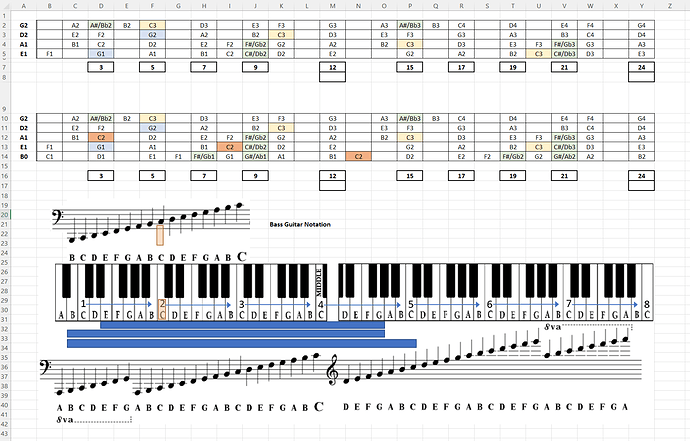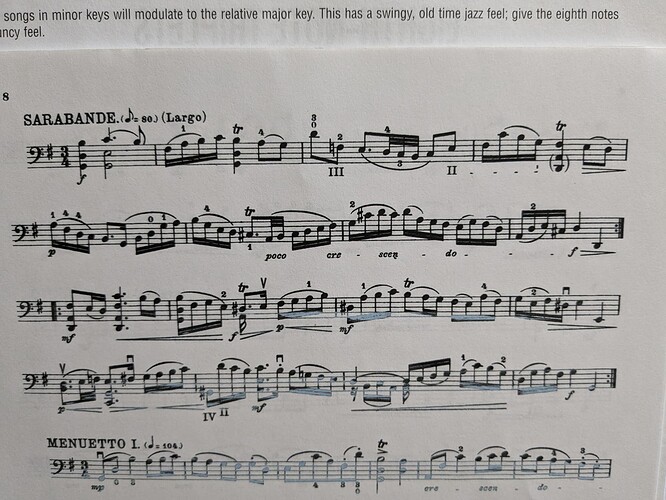I’ve been practicing how to read sheet music and understand the basics of what note is represented on the lines BUT one thing I can’t wrap my head around is knowing what fret I should press.
Ex: If the music sheet is telling me to play an F or B flat how do I know what specific F or a B flat on the fretboard I should play?
You don’t. Sheet music tells you the note and pitch but not where to play. While it’s great for piano, for example. The sheet music will tell you exactly where to play. On a Guitar or a bass guitar, it’s not as simple because the same pitch/ note can be played in multiple locations.
Bassists have to figure out the best path to play them.
Well - kind of. Sheet music definitely tells you the exact note to play - i.e. which note in which octave.
It’s true that there are usually multiple ways to fret the note but you at least know the exact note to play. You can’t play just any Bb ![]()
These might help. Do not take it as gospel, however. Everything is open to interpretation. This is just a starting point.
Note: I didn’t make these If I could remember who did I would totally give them all the credits.
Note that the bottom chart is notated for Piano and not Bass, and so is off by an octave compared to the first section of the top chart, which is transposed like a bass. Bass guitar standard notation is transposed up by one octave from piano notation. That’s why the note notated as C1 in the “8va… (octave down)” section on the top chart is notated as C2 on the bottom one (and later on the top one). Both are correct, just for different transpositions.
Transposing instruments like Bass can be confusing. Just be happy it’s transposed by an even octave; many instruments are not ![]()
Note that on the top chart, the only section that is notated correctly for bass is the first octave shifted down section. And that’s only correct if you ignore the shift and assume it is literal.
To put it most simply, on the bottom chart, the note notated as “C2” is actually C1 on bass.
Oh, this is brilliant, thank you. I’m much more of a visual learner and this is a huge help.
Cue my poor son and I banging heads with each other the other day. I didn’t know (or didn’t recall could be either, it’s been 30 years since I could read sheet music) that transposing was a thing and he was watching my lesson with Josh where you go up the scale in sharps and down in flats. Apparently on the French horn a F# and Gb are played differently so he says they aren’t the same note which I’m still not convinced about but that led into a very frustrating discussion about music notation. Poor kid was almost in tears until some googling on ‘Concert notes’ revealed the transposing bit.
I guess the teacher kept it very simplified for a bunch of 12 years olds in beginner band.
I feel his pain, I was a trumpet player. Those transpose to Bb - just one whole step off from piano.
Could you give me a quick rundown of what I’m looking at specifically? Sorry😅
Standard notation can indicate which string to play, it just usually doesn’t. I think it’s more common in classical guitar.
Technically it can convey any info since it’s legit to just write plain text on it
Yeah it’s quite personal sometimes. Some player like to move up/ down the neck and sometimes up/ down the strings. If you are blessed with both dexterity then it play it with the maximum economy of motion.
Yeah, though for for some notes (ten exactly, actually) there’s only one place on the instrument you can play it.
Yeah usually at the most inopportune time too, ![]()
Technically sure but specifically, it uses a number in a circle to denote the string that a note is played on. Also used are Roman numerals I to XII to indicate the fret.
Great Stuff Mr. Crispy. Signed up and did 3 lessons so far today. I’m pushing 70. Started in 2nd grade playing trumpet and know trebel clef pretty good. Put it all away 50 years ago. Base clef I had to research and adapt to the bass but I have had it for two days so I’m ignorant. Long road ahead. It is just something I want to do. For a couple coins at a music store they have charts and small books on just this topic.
I started on the piano at the age of 10, so I can read bass notes but as a new bass player I wasn’t sure where on the neck to play the notes. I try to find the closest notes and if available I get a score that has both standard notation and tab. That really helps me.
I don’t know classical guitar, but I know classical strings music well. It’s not uncommon for there to be info about where to play and what fingering to use, but it’s absolutely considered a suggestion in the vast majority of cases. In an orchestra you’re expected to play the fingering and bowing everyone else does, which may not be the fingering the editor put on the sheet music. If you’re a soloist you’re free to change it to suit you in a lot of cases.
Classical strings where to play tends to be communicated by Roman numerals indicating what position to play a phrase in though, for example:
Also the biggest advantage of traditional notation is rarely mentioned - it’s intuitive to sing/hum/visualize aurally a passage. Not very important if you have a recording to follow along to, but a far quicker path to understanding a passage with only notation.


